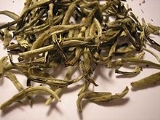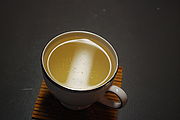
Bai Hao Yinzhen tea
Encyclopedia
Bai Hao Yinzhen, known also as Silver Needle, or White Down (Hair) Silver Needle is a white tea
produced in Fujian Province
in China
. Amongst white tea
s this is the most expensive variety and the most prized, as only top buds (leaf shoots) are used to produce the tea. Genuine Silver Needles are made from cultivars of the Da Bai (Large White) tea tree family. It is important to point out that there are other productions that look similar with downy leaf shoots but most are green teas, and as green teas, they taste differently and have a different biochemical potency than the genuine white tea Silver Needle.
 A genuine Silver Needle is a white tea
A genuine Silver Needle is a white tea
, and as a white tea, it is only lightly oxidized. The best productions are from the first flushes, which generally take place between late March to early April, when the year's first new buds "flush". For the production of Silver Needle, only the leaf shoots, i.e. the leaf buds before opening, are plucked. Unlike the plucking of green tea, the ideal time and weather for plucking white tea is a sunny morning when the sun is high enough to have dried any remaining moisture on the buds.
Traditionally, the plucks are laid in shallow baskets to wilt under the sun for an extended period, and the best quality produced today are still made this way. To avoid loss due to sudden rain, gusts, or other accidents, some producers are taking the plucks indoor to wilt in a chamber with artificial warm air flow. The softened shoots are then piled for the required enzyme oxidation (often incorrectly referred to as fermentation) before they are taken for a low temperature bake-dry.
Two regions, Zhenghe and Fuding, spanning the north to north-eastern parts of the Fujian province are the major and original producers of this tea, although neighboring counties have also been producing. The two major cultivars employed by these regions are Fuding Da Bai and Zhenghe Da Bai, named after their origins. These differences are important to distinguish the two major styles of Silver Needles — the Zhenghe style and the Fuding style. The former is usually a lot darker, with significantly longer piled-up time for oxidation, yielding a tea with fuller body than the latter style, which is generally lighter with shorter oxidation. The character of the tea tree leaves of the former allows for the extended piled-up time without turning bad. Both styles have their own group of followers, as taste is a rather personal preference.
White tea
White tea is a lightly oxidized tea grown and harvested almost exclusively in China, primarily in the Fujian province.White tea comes from the delicate buds and younger leaves of the Chinese Camellia sinensis plant. These buds and leaves are allowed to wither in natural sunlight before they are...
produced in Fujian Province
Fujian
' , formerly romanised as Fukien or Huguing or Foukien, is a province on the southeast coast of mainland China. Fujian is bordered by Zhejiang to the north, Jiangxi to the west, and Guangdong to the south. Taiwan lies to the east, across the Taiwan Strait...
in China
People's Republic of China
China , officially the People's Republic of China , is the most populous country in the world, with over 1.3 billion citizens. Located in East Asia, the country covers approximately 9.6 million square kilometres...
. Amongst white tea
White tea
White tea is a lightly oxidized tea grown and harvested almost exclusively in China, primarily in the Fujian province.White tea comes from the delicate buds and younger leaves of the Chinese Camellia sinensis plant. These buds and leaves are allowed to wither in natural sunlight before they are...
s this is the most expensive variety and the most prized, as only top buds (leaf shoots) are used to produce the tea. Genuine Silver Needles are made from cultivars of the Da Bai (Large White) tea tree family. It is important to point out that there are other productions that look similar with downy leaf shoots but most are green teas, and as green teas, they taste differently and have a different biochemical potency than the genuine white tea Silver Needle.
Production Processing

White tea
White tea is a lightly oxidized tea grown and harvested almost exclusively in China, primarily in the Fujian province.White tea comes from the delicate buds and younger leaves of the Chinese Camellia sinensis plant. These buds and leaves are allowed to wither in natural sunlight before they are...
, and as a white tea, it is only lightly oxidized. The best productions are from the first flushes, which generally take place between late March to early April, when the year's first new buds "flush". For the production of Silver Needle, only the leaf shoots, i.e. the leaf buds before opening, are plucked. Unlike the plucking of green tea, the ideal time and weather for plucking white tea is a sunny morning when the sun is high enough to have dried any remaining moisture on the buds.
Traditionally, the plucks are laid in shallow baskets to wilt under the sun for an extended period, and the best quality produced today are still made this way. To avoid loss due to sudden rain, gusts, or other accidents, some producers are taking the plucks indoor to wilt in a chamber with artificial warm air flow. The softened shoots are then piled for the required enzyme oxidation (often incorrectly referred to as fermentation) before they are taken for a low temperature bake-dry.
Two regions, Zhenghe and Fuding, spanning the north to north-eastern parts of the Fujian province are the major and original producers of this tea, although neighboring counties have also been producing. The two major cultivars employed by these regions are Fuding Da Bai and Zhenghe Da Bai, named after their origins. These differences are important to distinguish the two major styles of Silver Needles — the Zhenghe style and the Fuding style. The former is usually a lot darker, with significantly longer piled-up time for oxidation, yielding a tea with fuller body than the latter style, which is generally lighter with shorter oxidation. The character of the tea tree leaves of the former allows for the extended piled-up time without turning bad. Both styles have their own group of followers, as taste is a rather personal preference.
Tasting and brewing
As with all white teas, it is best prepared with water below boiling (at around 75 to 80 degrees Celsius or 167 to 176 degrees Fahrenheit) and produces a slightly viscous glittering pale yellow color with evidence of floating white hairs that reflect light. The flavor and fragrance should be delicate, light, fresh, and sweet. Steeping should be longer than other white teas; up to 5 minutes per brew, and the volume of tea to be used can be higher. There are few parallels to be drawn as the taste is not similar to any other teas but Bai Mu Dan, except the latter is fuller but not as sweet and delicate.External links
- Linus Pauling Institute on white tea

